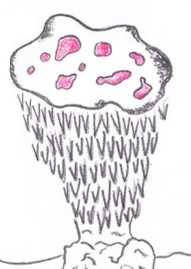
Glossary
Archaeplastida-a monophyletic of autotrophs that are "descendants from an ancient protists that engulfed a cyanobacterium"(Campbell et al. 2008).
autodidact-one who is self-taught.
basidiocarp-the fruiting body of a fungus in the phylum Basidiomycota.
basidium- the club shaped structure that members of the phylum Basidiomycota bear their spores on.
clamp connections- "backwardly directed hyphal branches"(Moore et al. 2011) that reach out like pseudopodia and fuse to the parent hyphae to ensure that one nuclei gets to each side of the septum upon mitosis.
dikaryotic- a term used to describe fungi having two nuclei from different parents. (di = two; karyo= nucleus).
ectomycorrhiza-(singular)-a symbiotic association between a fungus and plant in which the roots of the host plant are enveloped in a 'sheath' of fungal hyphae. (ecto= outside; myco=fungus; rhiza=root). (plural=ectomycorrhizae).
heterotrophic- refering to organisms that can't make their own food and must obtain their nutrition from other sources. (hetero=other; trophe=nourishment).
humus- a dark nutrient-rich component of soil that is made up of decomposing organic matter.
hymenophore-(aka hymenium)- the spore-bearing surface of a mushroom. Hymenophores can take a variety of forms such as gill, pores, folds, or teeth. The common button mushroom's hymenophore, for example, is its collection of fragile brown gills, while H. peckii's hymenophore is its scores of tooth-like projections.
hypha-(singular)-a threadlike vegetative growth form of fungi. (plural=hyphae).
karyogamy- the fusion of two nuclei to for a diploid cell. (karyo=nucleus; gamy=marriage).
lanolin-a waxy substance produced by sheep and other wooly animals that coats their wool.
monophyly- a group of organisms consisting of "an ancestral species and all of its descendants" (Campbell et al., 2008).
mycelium-(singular)-all of the hyphae of a single fungus. The collective hyphae from more than one or an uncertain number of fungi are called mycelia.
mycologist- one who studies fungi.
mycophagist-one who eats mushrooms.
Opisthokonta-a monophyletic group of organisms that possess a single posterior flagellum at some point in their development. (opisthos=hind; kontos=pole) (Cambpell et al, 2008).
pileus- the cap of a fungus that supports the spore-bearing surface.
plasmogamy- the fusion of the plasma of two hyphae with complimentary mating types to produce a single dikaryotic mycelium. ('plasmo-' refers to cytoplasm; gamy=marriage).
sapotrophy- the act of obtaining nutrients by feeding on dead or decaying matter.
septum-a pored wall within the hypha of a fungus that partitions the nuclei of the fungus while simultaneously permitting cytoplasmic flow. (plural=septa)
stipitate hydnoid fungi- tooth fungi that have a stem. (Stipitate come from "stipe" which is another word for a stem; hydnoid comes form hydnum which means tooth in Greek).
